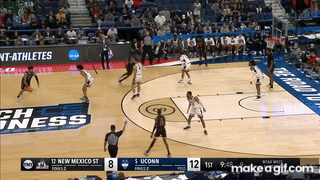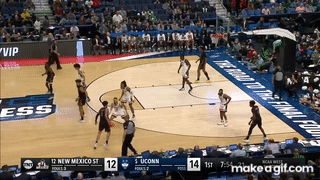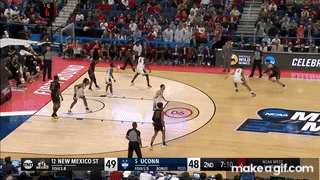A second straight Sweet Sixteen birth is on the line as Arkansas takes on potential Cinderella New Mexico State, who knocked off UConn 70-63 on Thursday.
Meet the Aggies
Confused? Check out the advanced stats glossary to learn more about the stats cited here.
There are a lot of similarities between Vermont and New Mexico State. Both have dominated their conferences for several years now, but while Vermont’s success has all been under Coach John Becker, the Aggies have been the premier WAC school under three coaches: Marvin Menzies started the dynasty, reaching five NCAA Tournaments in nine seasons from 2007 to 2016, then Paul Weir made one in his only season in 2017, and now Chris Jans is making his third in five seasons (and it would have been four if the 2020 tournament wasn’t canceled due to COVID).
Scouting Report
Here’s a quick overview of what’s discussed in this article:
- New Mexico State’s offense plays at a slow pace and prefers a halfcourt game. The Aggies will launch a ton of 3-pointers, but they struggle to get to the rim and struggle to protect the basketball. They crash the offensive glass well and are one of the nation’s better teams at quick putbacks off missed shots.
- Teddy Allen (37 points vs. UConn) is the type of player that’s very dangerous in the NCAA Tournament… but he’s also the type of player Arkansas has defended well all year. The Aggies don’t have a dangerous big man.
- The Aggie defense lays a trap for teams looking to run: they’ll let you get in transition due to their high turnover rate, but they are among the nation’s best teams at preventing teams from scoring in transition.
- You’re better off attacking New Mexico State’s halfcourt defense, which is pedestrian. The Aggies struggle to force turnovers and aren’t great against jump shooters. They do defend very well at the rim, however, and they don’t foul a lot.
Our model’s pick is Arkansas 73, New Mexico State 70.
Team Profile

As mentioned in the Box Score Breakdown from the Vermont game, we’ve got a new model so these preview tables will look a bit different, although the topline numbers like the ones in the table above are still the same. Be sure to check out the updated glossary for more on the stats we use.
Personnel Profile

To win in March, you need four key ingredients: prevent shots at the rim, defend the 3-point line, be able to score on offense in multiple ways, and have a dominant guard capable of taking over a close game. As we’ll see below, the Aggies have the first three. And as you see in the table above, the Aggies also have the fourth. Teddy Allen went off for 37 points in the 70-63 win over UConn. His 30% usage is as high as JD Notae’s, so the Aggies have no problem standing back and letting him cook. He is the guy to watch.
Now, there’s good news here. This was a terrible matchup for UConn, who struggles against opposing off-ball guards, a fact I noted when previewing the UConn-NMSU game. But Arkansas’ defense does not struggle against off-ball guards; in fact, the Hogs’ defensive specialty is shutting them down. Our numbers show Arkansas ranks 11th nationally in total defense against shooting guards by game score. The Hogs have struggled against bigs, but New Mexico State has no Ryan Davis, so this will be a very different game.
When Arkansas has the ball

There’s an even matchup of Arkansas’ 50th-ranked offense against New Mexico State’s 62nd-ranked defense. On paper, the Aggies aren’t quite as good as Vermont defensively, but they are very similar in terms of style. Let’s start by looking at hustle possessions:

Arkansas gets a lot of hustle offense, ranking 30th in transition points per 100 possessions and 63rd in putback points per 100 possessions. The Hogs get into transition on 25% of possessions — good for 27th nationally — but only had 20% against Vermont.
New Mexico State is interesting, as they allow too many transition possessions (276th), but do a good job of preventing offenses from converting them into points (5th). The Hogs may be able to run, but should they want to?
UConn walked right into this trap. The Huskies got in transition on 30% of possessions… but converted on just 35% of them. UConn actually matched the Aggies’ efficiency in halfcourt, but the lost possessions from trying to play a transition game cost them. Arkansas just outmatched Vermont in a halfcourt game, so the Hogs may should stick to that.
(NOTE: I would love to show you gifs of how New Mexico State defended UConn in transition, but the NCAA is really strict with its video policy during March Madness, allowing only their own highlight videos to be distributed. Naturally, good team defense didn’t make the cut.)

The Aggies only rank 161st in halfcourt efficiency defense, so there’s no issue in slowing down and setting up an attack against them. The Aggies do a lot well in the halfcourt — namely, they don’t allow many shots at the rim (36th), but they allow opponents too many chances to score. That’s what EPR is measuring — shot creation — specifically, scoring chances per 100 halfcourt possessions. The Aggies’ defense is 271st in scoring chances per 100 halfcourt possessions and 327th in field goal attempts allowed per 100 possessions. The Hogs have been great at shot creation all year (shot making, not so much), so expect that to continue.
The Arkansas offense doesn’t take many 3-pointers, preferring midrange jumpers when a shot at the rim isn’t available. These aren’t very efficient shots, but the Hogs are pretty good at hitting them (96th), which creates a lot of problems as modern defenses largely focus on defending the perimeter and the rim, not the midrange game. New Mexico State falls into that category, as they force the 61st-most midrange jumpers against them due to their good defense at the rim.
Arkansas hit 39% on midrange jumpers against Vermont, and the Hogs will be in great shape if they can do that again.
When New Mexico State has the ball

New Mexico State buried UConn from deep, hitting 11 of 17 3-pointers in the win. UConn’s awful 3-point defense was a known entity heading into the game, so again, bad matchup. But the Hogs aren’t great against the 3 either. The real question will be can New Mexico State repeat their hot shooting? They may not get much else.

The Hog defense is strong in transition, ranking 25th in opponent transition conversions. New Mexico State doesn’t run much but they usually convert when they do run. They didn’t run at all against UConn — just 8% of their possessions were in transition — and that’s probably smart given UConn’s athleticism. The same can be said against Arkansas’ defense.
The Aggies can be dangerous at converting missed shots into quick putbacks, so the Hogs need to rebound well. That’s a big different between NMSU and Vermont. About 7% of Aggie missed field goals end up in quick buckets at the rim.
Now for the halfcourt game:

The Aggies are good but not great here.
Shot creation is their weakness. Despite solid offensive rebounding, New Mexico State turns the ball over like crazy, which limits the number of shots they are able to get off in the halfcourt (167th in EPR, 175th in FG Rate). Arkansas has ben very good at limiting shot opportunities this season, ranking 31st.
The Aggies are pretty good at the actual scoring part. Like Vermont, they’ll take a ton of 3-pointers, but unlike Vermont, they aren’t great at hitting them (182nd in 3FG%). Also unlike Vermont, the Aggies really struggle to get to the rim, taking just 30% of field goals there (261st). Arkansas’ defense has been great at limiting rim opportunities this year (67th), forcing opponents instead to take lower-percentage mid-range jumpers.
Like Vermont, the Aggies lack a traditional post player and will play with good spacing around the perimeter. Six of the eight players on the roster table above take 40% or more of their shots from the beyond the arc, but no one takes more than 67% from 3.
One key difference is that while was Vermont was very balanced and didn’t have a dominant guard, the Aggies do. They’ll frequently spread out and let Teddy Allen go to work:

Like most teams, the Aggies will use ball screens to set up open shots. Shots off dribbles usually aren’t very high-percentage, but for Allen against UConn, they were deadly:

Again, not a whole lot of X’s and O’s here. Allen was just feeling it:

I’m not sure what you do if he gets hot like this again. It will put the madness in Eric Musselman’s March.
Keys to the Game
#1 Tap the breaks.
The Hogs love to run. Playing fast and aggressive is a signature part of Eric Musselman’s coaching style and Arkansas basketball history. But sometimes, it’s better to play under control instead of trying to run. New Mexico State’s defense will let you run and then punish you for it. If the Hogs get wreckless by trying to go too fast, it could cost them.
#2 Stick with shooters on the perimeter.
I thought the Hogs did fine defending the perimeter against Vermont. A similar effort is probably all that’s needed against a worse shooting team. While New Mexico State isn’t as good at hitting 3-pointers, they were blazing hot against UConn. Maybe lightning strikes twice… or maybe the Aggies have burned out their best effort.
#3 Limit Aggie shots.
As we discussed, New Mexico State struggles to get shots up in their halfcourt offense due to a high turnover rate. Forcing turnovers and keeping them off the glass will be key, especially if Teddy Allen (or someone else) gets hot from the field.
The latest from Fayette Villains, straight to your inbox
Enter your email to subscribe and receive new post alerts and other updates. You can unsubscribe at any time.
